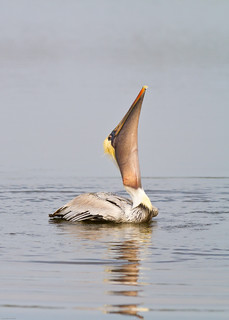 |
| Photo taken by Cindy Elder |
If you've ever taken an auto trip, you've probably seen bicyclists riding closely behind each other in a straight line. This technique, called a "pace line," allows the riders an opportunity to "draft" the cyclist just in front, cutting down wind resistance for subsequent riders. And if you've walked one of our beaches you probably have seen brown pelicans, Pelecanus occidentalis, flying in a similar formation. What those pelicans do instinctively takes most bicyclists weeks or months to perfect. For a brown pelican that can weigh up to 15 pounds, it's truly an energy-saving technique, allowing these birds to ride the marine air currents, rising and falling with the waves, with minimum effort.
Brown pelicans can be found from the coasts and estuaries of the mid-Atlantic and around the Gulf of Mexico. Some groups may migrate several hundred miles during the year, while others live their lives around the same shorelines. Whether they migrate or not, pelicans are never far from land and relatively shallow water depths. These are the areas in which they feed and breed. And if you think the pelican pace line is a pretty savvy way to get around, you'll be impressed at their fishing technique. A pelican's method of catching fish can be compared to a defensive end's approach to tackling the runner in a football game. Both dive right at their target with head tucked, and in the case of the pelican, with a slight rotation to the left (to protect the trachea on the right side of the bird's neck). The impact of the hit stuns the target (in the football game it at least shuts down the ball's advance toward the goalposts). The pelican's goal is to consume the fish knocked unconscious by the force of its collision with the water. Both the defensive end and the pelican have their protective equipment. Shoulder pads and a helmet for the man, air sacs beneath the pelican's skin that inflate like little air bags.
 P. occidentalis is not a dainty eater; it expands its trachea, quickly taking in both fish and water before the fish recover from the blow. Nearby seagulls flock to the dive site, knowing the pelican must open its bill upon surfacing in order to rid itself of the water before swallowing its meal. The gulls will attempt to literally snatch the food out of the pelican's mouth; the ensuing scramble is reminiscent of the post-play pile-ons so commonly seen in football. Considering how last Sunday's game went against the Eagles, our Jacksonville Jaguars might benefit from a lesson in tackling given by P. occidentalis.
P. occidentalis is not a dainty eater; it expands its trachea, quickly taking in both fish and water before the fish recover from the blow. Nearby seagulls flock to the dive site, knowing the pelican must open its bill upon surfacing in order to rid itself of the water before swallowing its meal. The gulls will attempt to literally snatch the food out of the pelican's mouth; the ensuing scramble is reminiscent of the post-play pile-ons so commonly seen in football. Considering how last Sunday's game went against the Eagles, our Jacksonville Jaguars might benefit from a lesson in tackling given by P. occidentalis.Come to the GTM Research Reserve's Family ecoMENTALITY National Estuaries Day on September 27 and you'll be able to watch this triathlete's skill: flying, and fishing, and the diving play-by-plays of pelican vs. gull right at the estuary's line of scrimmage.
Resources


